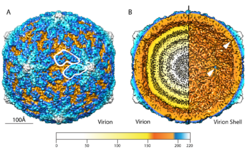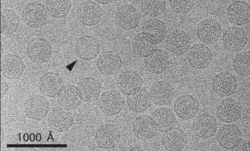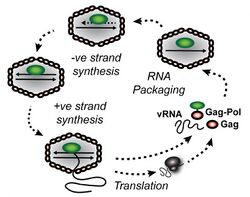Biology:Totiviridae
| Totiviridae | |
|---|---|

| |
| Capsid structure of Helminthosporium victoriae virus 190S (HvV190S) | |

| |
| Cryo-EM of HvV190S virions. | |
| Virus classification | |
| (unranked): | Virus |
| Realm: | Riboviria |
| Kingdom: | Orthornavirae |
| Phylum: | Duplornaviricota |
| Class: | Chrymotiviricetes |
| Order: | Ghabrivirales |
| Family: | Totiviridae |
Totiviridae is a family of double-stranded RNA viruses. Giardia lamblia, leishmania, trichomonas vaginalis, and fungi serve as natural hosts. The name of the group derives from Latin toti which means undivided or whole. There are 28 species in this family, assigned to 5 genera.[1][2]
Structure
Viruses in the family Totiviridae are non-enveloped, double-stranded RNA viruses with icosahedral geometries, and T=2 symmetry. The virion consists of a single capsid protein and is about 40 nanometers in diameter.[1]
Genome
The genome is composed of a monopartite, linear double-stranded RNA molecule of 4.6–6.7 kilobases. It contains two overlapping open reading frames (ORF) – gag and pol – which respectively encode the capsid protein and the RNA-dependent RNA polymerase. Some totiviruses contain a third small potential ORF.[1]
Life cycle

Viral replication is cytoplasmic. Replication follows the double-stranded RNA virus replication model. Double-stranded RNA virus transcription is the method of transcription. Translation takes place by -1 ribosomal frameshifting, +1 ribosomal frameshifting, viral initiation, and RNA termination-reinitiation. The virus exits the host cell by cell-to-cell movement. Giardia lamblia protozoa, leishmania protozoa, protozoan trichomonas vaginalis, and fungi serve as the natural host.[1]
| Genus | Host details | Tissue tropism | Entry details | Release details | Replication site | Assembly site | Transmission |
|---|---|---|---|---|---|---|---|
| Giardiavirus | Protozoa | None | Cell receptor endocytosis | Exocytosis | Cytoplasm | Cytoplasm | Passive diffusion |
| Leishmaniavirus | Protozoa: leishmania | None | Cell receptor endocytosis | Cell division | Cytoplasm | Cytoplasm | Cell division |
| Totivirus | Fungi: saccharomyces cerevisiae; fungi: smut fungi | None | Cytoplasmic exchange, sporogenesis; hyphal anastomosis | Cytoplasmic exchange, sporogenesis; hyphal anastomosis | Cytoplasm | Cytoplasm | Cell division; sporogenesis; cell fusion |
| Victorivirus | Fungi | None | Unknown | Unknown | Cytoplasm | Cytoplasm | Unknown |
| Trichomonasvirus | Protozoa | Endocytosis | Unknown | Unknown | Cytoplasm | Cytoplasm | Unknown |
Taxonomy
The family Totiviridae has five genera:[2]
Examples
An example of fungal totivirus is the L-A helper virus, a cytoplasmic virus found primarily in Saccharomyces cerevisiae.[3]
References
- ↑ 1.0 1.1 1.2 1.3 "Viral Zone". ExPASy. http://viralzone.expasy.org/all_by_species/161.html.
- ↑ 2.0 2.1 "Virus Taxonomy: 2020 Release". International Committee on Taxonomy of Viruses (ICTV). March 2021. https://ictv.global/taxonomy.
- ↑ Rodríguez-Cousiño, Nieves; Esteban, Rosa (9 December 2016). "Analysis of L-A-2, the helper virus of K2 killer toxin-encoding M2 dsRNA, and of L-BC variants from wine yeast strain populations provides new insights into the relationship and evolution of dsRNA viruses of yeast". Appl. Environ. Microbiol. 83 (4). doi:10.1128/AEM.02991-16. PMID 27940540. PMC 5288835. https://aem.asm.org/content/aem/early/2016/12/05/AEM.02991-16.full.pdf.
External links
Wikidata ☰ Q1950725 entry
 |


